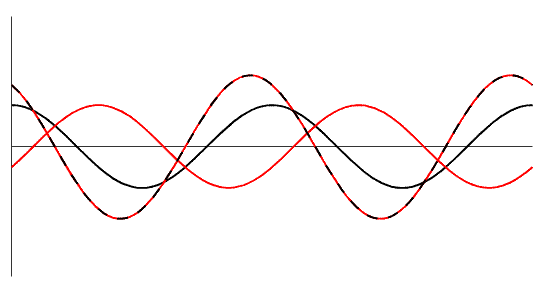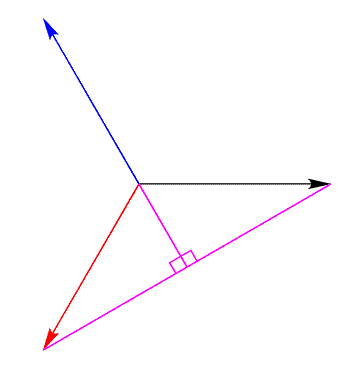You are using an out of date browser. It may not display this or other websites correctly.
You should upgrade or use an alternative browser.
You should upgrade or use an alternative browser.
phase to phase voltage
- Thread starter wankster
- Start date
- Status
- Not open for further replies.
triplstep
Member
- Location
- Aurora, Illinois
In a 3 phase wye system, the voltage measured line to line is not the
sum of the phase voltage, because the voltage potential are out of phase by 120 degrees.
sum of the phase voltage, because the voltage potential are out of phase by 120 degrees.
LarryFine
Master Electrician Electric Contractor Richmond VA
- Location
- Henrico County, VA
- Occupation
- Electrical Contractor
Draw a Y with three equal-known-length and equally-spaced arrows. Now, measure the distance from arrowtip to arrowtip, as the side of an equilateral triangle, and compare it to the arrow length.
Sinusoidal waveform formulas:Can someone explain to me why phase to phase voltage is multiplied by radical 3 in a three phase system? I just asked my trig teacher and he couldn't help!
L1-N voltage = cos(ωt)
L2-N voltage = cos (ωt - φ)
L1-L2 voltage = cos(ωt) - cos (ωt - φ)
where:L2-N voltage = cos (ωt - φ)
L1-L2 voltage = cos(ωt) - cos (ωt - φ)
ω = angular frequency, i.e. 360??60cycles/sec = 21,600?/sec
t = time in seconds
φ = phase difference, here it is 120? or (120/180*pi) radians
When you plot out the last waveform, you will find:t = time in seconds
φ = phase difference, here it is 120? or (120/180*pi) radians
L1-L2 voltage = √3 ? cos(ωt - 330?)

Pierre C Belarge
Senior Member
- Location
- Westchester County, New York
You may be thinking of the Square Root of 3, which is 1.732 - 3 phase multiplier.
Draw a Y with three equal-known-length and equally-spaced arrows. Now, measure the distance from arrowtip to arrowtip, as the side of an equilateral triangle, and compare it to the arrow length.
Isosceles triangle maybe?
No question here... isoceles triangle definitely!Isosceles triangle maybe?
120? at the vertex of the equal sides; 30? at the vertices of the equal sides with the unequal side. The relationship can be depicted as two back-to-back 30?-60?-90? triangles. As trig goes, the relationship of the long leg to hypotenuse is (√3)/2. So two long legs ios √3 times either hypotenuse.
- Location
- Lockport, IL
- Occupation
- Retired Electrical Engineer
The OP said "radical 3." The term "radical" is equivalent to "square root of."You may be thinking of the Square Root of 3, which is 1.732 - 3 phase multiplier.
- Location
- Lockport, IL
- Occupation
- Retired Electrical Engineer
Send me a PM with your email address. I can send you a trigonometric derivation of the formulas for power in single phase and three phase systems. Give them to your trig teacher, and let us know what he says.I just asked my trig teacher and he couldn't help!
This is a little longer version and may be over your trig teachers head.
The power in watts is equal to volts times amps, but
we must use "phase" volts and "phase" amps to calculate power.
Calculating these phase relationships requires a little bit of
trigonometry.
..
Assuming a balanced load, the current in any of the three phases is the
same as that measured in each line because the line will be attached to
one end of the phase so there cannot be any difference. We need the
phase voltage times the phase current to get the phase power.
There are two phases connected between each pair of lines in a "Y"
circuit, and since the voltages are not in phase, they do not add together
to make the line voltage twice the phase voltage. It turns out through
some basic trigonometry, that the line voltage is equal to each of the two
phase voltages times the sine of 120 degrees, and the sine of 120 degrees
is "one-half" the square root of 3. Adding those two halves together
gives the LINE voltage as the square root of 3 times the phase voltage.
Or conversely the phase voltage is the line voltage DIVIDED by the square
root of 3.
So the power in any phase, assuming, again, a balanced load is
the line voltage times the line current divided by the square root of 3.
For the three phases, then, the total power is three times the power in
any phase. 3 X the line voltage X the line current divided by the square
root of 3. 3 divided by the square root of 3 simplifies to just the
square root of 3. Multiplying that, as you noted, by the power factor
converts volt-amps to watts assuming the power factor is other than one.
In a delta connected circuit, the same problem exists
except with the current measurement. Here, the line to line voltage
measurement is the phase voltage, but the line current is composed of two
currents that are out of phase by 120 degrees, and you guessed it, the
"vector sum" of the two phase current components is the square root of
three times the current in any phase. And, the phase current is the line
current divided by the square root of 3, so the power equation works
exactly the same for both the "Y" and the Delta connected circuits.
The power in watts is equal to volts times amps, but
we must use "phase" volts and "phase" amps to calculate power.
Calculating these phase relationships requires a little bit of
trigonometry.
..
Assuming a balanced load, the current in any of the three phases is the
same as that measured in each line because the line will be attached to
one end of the phase so there cannot be any difference. We need the
phase voltage times the phase current to get the phase power.
There are two phases connected between each pair of lines in a "Y"
circuit, and since the voltages are not in phase, they do not add together
to make the line voltage twice the phase voltage. It turns out through
some basic trigonometry, that the line voltage is equal to each of the two
phase voltages times the sine of 120 degrees, and the sine of 120 degrees
is "one-half" the square root of 3. Adding those two halves together
gives the LINE voltage as the square root of 3 times the phase voltage.
Or conversely the phase voltage is the line voltage DIVIDED by the square
root of 3.
So the power in any phase, assuming, again, a balanced load is
the line voltage times the line current divided by the square root of 3.
For the three phases, then, the total power is three times the power in
any phase. 3 X the line voltage X the line current divided by the square
root of 3. 3 divided by the square root of 3 simplifies to just the
square root of 3. Multiplying that, as you noted, by the power factor
converts volt-amps to watts assuming the power factor is other than one.
In a delta connected circuit, the same problem exists
except with the current measurement. Here, the line to line voltage
measurement is the phase voltage, but the line current is composed of two
currents that are out of phase by 120 degrees, and you guessed it, the
"vector sum" of the two phase current components is the square root of
three times the current in any phase. And, the phase current is the line
current divided by the square root of 3, so the power equation works
exactly the same for both the "Y" and the Delta connected circuits.
zog
Senior Member
- Location
- Charlotte, NC
Here is the easy version
WIDE
WIDE
Can someone explain to me why phase to phase voltage is multiplied by radical 3 in a three phase system? I just asked my trig teacher and he couldn't help!
Of course, the teacher is a mathematician, not an engineer.
But to answer your question in the simplest terms, two of the voltages may be represented in polar form as static phasors although many persist in calling them vectors. For example:
Van = 120Vrms @ +60 deg
Vbn = 120Vrms @ -60 deg
then,
Vab = Van - Vbn = 120Vrms[cos(60) - cos(-60) + jsin(60) -jsin(-60)]
= 120Vrms[2sqrt(3)/2] = 1.732 x 120Vrms = 208Vrms @ 90 degrees.
please note that the sqrt(3) factor applies only if the phase voltages are equal and spaced at 120 degrees.
LarryFine
Master Electrician Electric Contractor Richmond VA
- Location
- Henrico County, VA
- Occupation
- Electrical Contractor
I'm thinking this drawing with two more pink lines. Looks equilateral to me.Isosceles triangle maybe?
Supporting graphic...

Added: But, yes, as drawn, 1/3 of the equilateral is an Isosceles.
Last edited:
- Status
- Not open for further replies.
